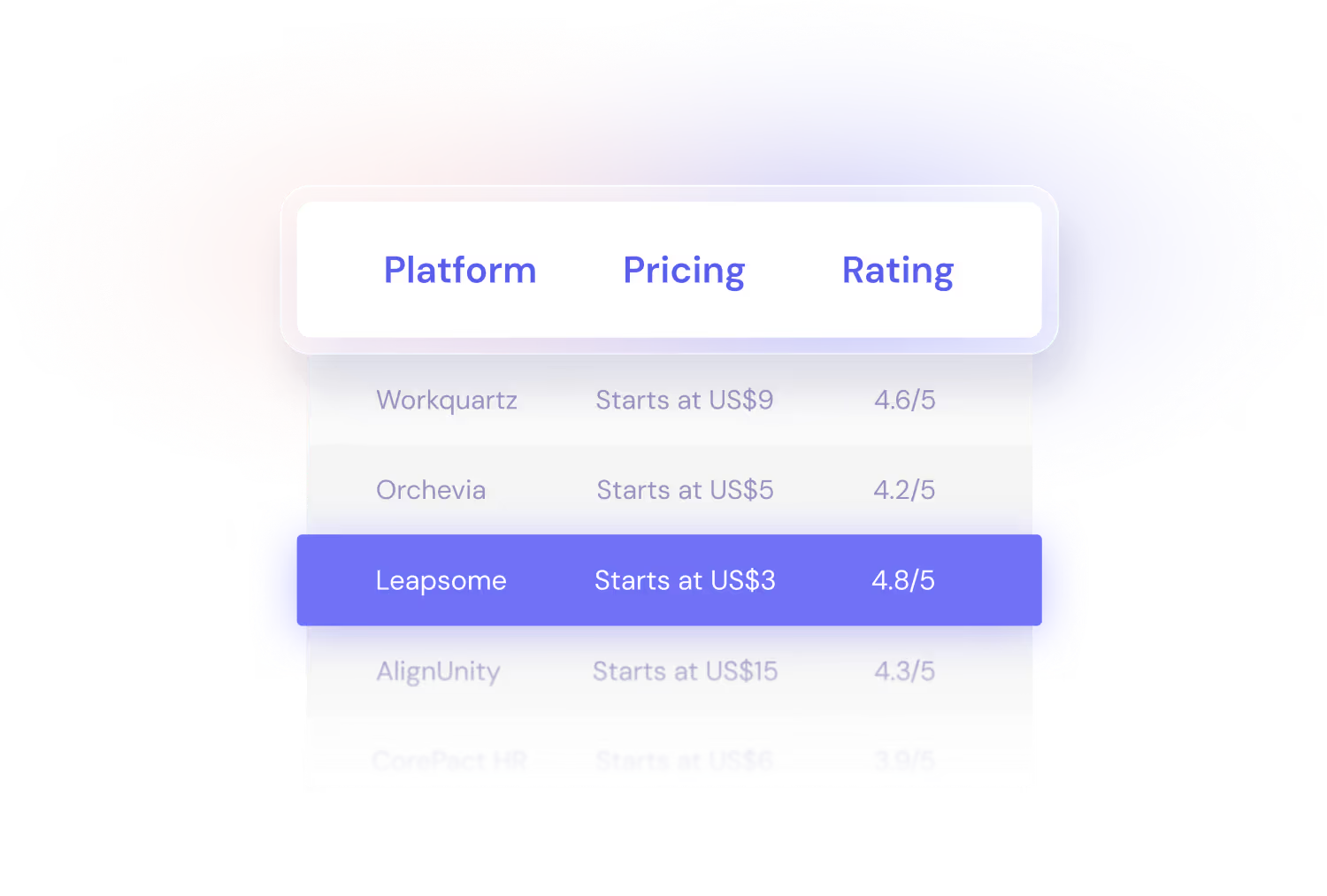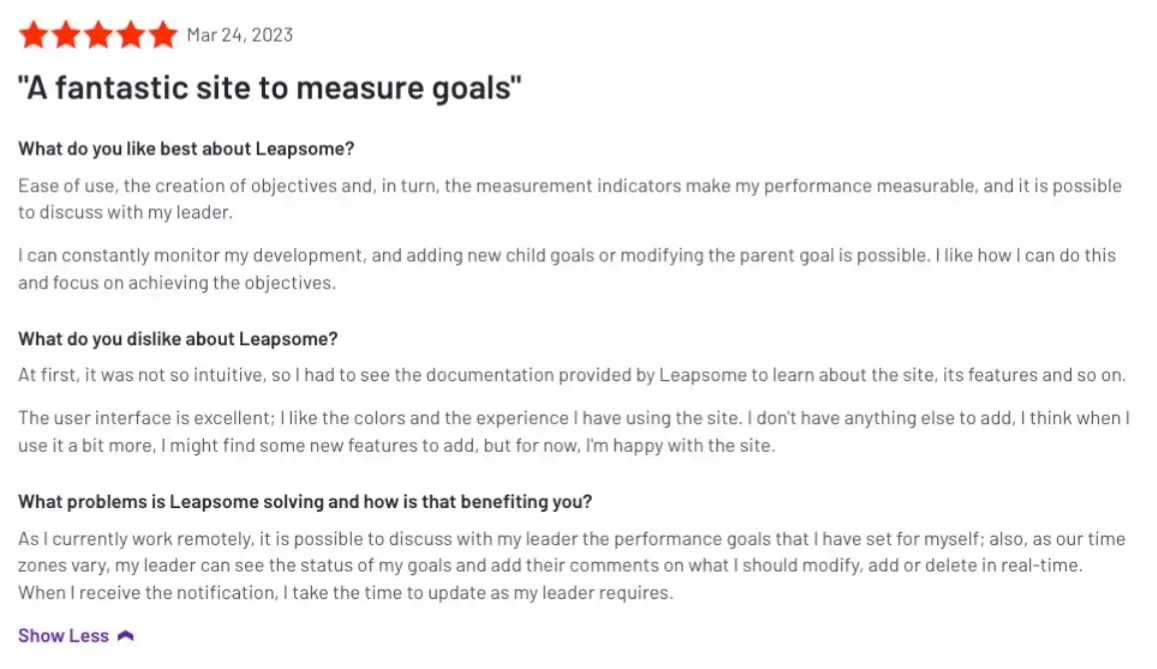Top 10 Perdoo alternatives & the best OKR solutions in 2026

Perdoo is an objectives and key results (OKR) and key performance indicator (KPI) management software solution that can help align teams behind common business goals and break down ambitious objectives into smaller, more manageable tasks. Perdoo users appreciate how the platform allows individuals to see how their work contributes to their organization’s broader success.
But if your company is new to the OKR goal-setting framework, Perdoo may not be the right solution for you. Customers say they feel left alone when figuring out how to create OKRs with the platform, and the interface can be a bit clunky. Plus, it lacks built-in functions that let you take direct action on your goals, like essential features for gathering feedback and frameworks for career development.
If you're looking to lastingly impact your employees’ performance and productivity, there are solutions that can take you further than Perdoo. In this guide, we’ll explore ten Perdoo alternatives and break each one down based on best use case, top features, pros and cons, and pricing to help you make a well-informed choice for your organization.*
*The information below is based on our research on Perdoo competitors. All user feedback referenced in the text has been sourced from independent software review platforms such as G2 and Capterra in March 2023.

Key features to help you track goals & manage performance
The OKR goal-setting framework can sometimes feel intimidating. But there are platforms that can help you set it up and incorporate it into your teams’ weekly and monthly workflows. Let’s look at some key features and elements to keep top of mind during your search:
Progress monitoring and check-ins
Regularly tracking OKRs makes it easier to identify barriers to success and keep everyone accountable. Prioritize a platform that has check-in tools so you can assess how each objective and key result is coming along.
Built-in performance management system
Only 35% of organizations report their team members feel performance evaluations are fair. If you struggle with unconscious bias in performance reviews, you may benefit from a platform that connects objective goals with appraisal processes.
Customizable learning paths
If development goals are among your team OKRs, you need a software solution that has native course creation features. That way, leadership can proactively design the training programs employees need, and team members can immediately take action to develop their skills.
Ease of use and customization
Intuitive software has higher adoption rates, which means more people will use it, making it more likely to have a widespread, positive impact on your business.
Integrations
You want your tool to seamlessly integrate with other software you're already using. This can save you a ton of time during set up and upkeep of your tool stack.
Pricing and affordability
We recommend software with customizable paid plans rather than tiered pricing models, as these prevent you from accessing specific tools until you upgrade to a more expensive option. When platforms have a pick-and-choose style system, where you can select the ideal combination of features for your needs, it means that you can cover all your bases without paying enterprise-level prices.
We recommend software with customizable paid plans rather than tiered pricing models, as these prevent you from accessing specific tools until you upgrade to a more expensive option. When platforms have a pick-and-choose style system, where you can select the ideal combination of features for your needs, it means that you can cover all your bases without paying enterprise-level prices.
1. Leapsome

Leapsome is more than just an OKR platform. It’s a holistic people enablement software solution that helps you to connect goals to feedback processes, development, and compensation decisions to drive performance and results, develop employees, and take meaningful action on employee surveys with five modules:
- Reviews
- Goals
- Surveys
- Learning
- Compensation
Our platform is also customizable, which means you can choose the modules that are most useful to your company. Our modules are designed to complement each other and work best when utilized together, helping you enhance your existing HR processes and create real value for your organization.
Unlike Perdoo, which only has features for tracking OKRs, KPIs, and performance reviews, Leapsome has everything you need to meet organizational, team, and individual objectives. Users can do the following:
- Establish transparent and realistic goals and OKRs and assign directly responsible individuals (DRIs) to take ownership of specific key results.
- Set up a goal tree to show employees clearly how individual, team, and company goals relate to one another.
- Discuss OKR progress in structured team meetings and 1:1s, record notes directly in the agenda, and migrate any unresolved talking points to future discussions.
- Give praise and instant feedback and recognize employees for reaching goals.
- View individual goal progress during performance reviews to provide fair, development-oriented feedback.
- Set up pulse surveys about current OKR processes that provide action plan recommendations based on results.
- Refer to competency frameworks before and after meeting certain OKRs to help divulge which personal goals employees should prioritize next.
- Use our promotion and compensation management features to set up fair promotion processes based on goal achievement.
Notable features
- Trackable, flexible goal and OKR management features with integrated comments and feedback tools for optimal collaboration
- Goal status updates
- Goal trees
- Goals module that syncs with 1:1 meetings and performance reviews to support discussing progress
- Questionnaire templates and action-driven surveys
- Powerful data and analytics
- Competency Framework
- Feedback and praise features
- Integrated compensation and promotion management tools to reward team members

- Lets you give instant feedback and set up meetings to discuss progress on goals
- All-in-one solution for people management and enablement processes
- Award-winning customer service that replies within 12 hours
- Supports 38 languages
- Scalable and customizable
- Easily navigable user interface (UI)
- Ongoing improvement can lead to occasional bugs
- No mobile app yet
- Variety of features can present a bit of a learning curve
What success looks like with Leapsome
Keep global teams on track
Customers love how easy it is to collaborate on goals and OKRs with Leapsome, even remotely.
Book your demo
2. Asana

Asana is a well-known project management software solution that businesses use to improve their efficiency, collaborate on tasks, and follow initiatives from ideation to execution. Unlike Leapsome, it doesn’t handle engagement and enablement processes like conducting surveys or coordinating performance reviews, but it does have useful features for creating and tracking goals. As such, Asana might be a good choice for your team to use alongside your people enablement software for more granular project management.
What makes Asana especially user-friendly is that you get a detailed view of:
- Every larger goal and smaller linked objectives
- Any connected projects
- Smaller tasks and sub-goals
- The project owner and who is responsible for each task
This allows HR teams to see what’s helping or hindering success. On top of that, the reporting dashboard provides a high-level overview of all departmental goals based on their status and progress, allowing leadership to check in when needed.
Notable features
- Customizable automations for project workflows
- Goals and OKR management
- Kanban boards for monitoring project status
- Gantt charting feature for mapping out project timelines
- Reporting and analytics
- Great for teams that are transitioning from a spreadsheet system
- Customers appreciate the automated workflows
- Flexible and customizable
- list item
- You have to pay for the most expensive plan to access the Goals feature
- Slight learning curve when it comes to navigating its features
- list item
3. Betterworks

Connecting company goals with employee reviews makes for a less subjective and more data-driven evaluation process. As a performance management software tool, Betterworks makes regular assessments more objective with its Conversations feature, which team leads can use to structure discussions around goal-setting, career development, and individual performance.
One of Betterworks’ most interesting functions is the Performance Snapshot sidebar that appears during check-ins. This feature gives managers an overview of each employee’s current objectives and previous feedback so they won’t need to toggle between dashboards during discussions.
Notable features
- Goals and OKR management
- Customizable meeting agenda templates
- Automations for scheduling staff feedback
- Recognition and praise features
- Templates for performance reviews and check-ins
- Employee engagement surveys
- Analytics and reporting dashboards
- Many helpful tutorials and guidance for setting up OKRs
- Helpful support team for solving backend issues
- User-friendly UI
- list item
- Users sometimes feel they have more features than needed
- Difficulty integrating with third-party tools
- list item
4. ClickUp

ClickUp is another project management platform that’s similar to Asana. It helps teams streamline their workflows and keep processes agile with customizable tasks and subtasks. It’s so granular that many users feel overwhelmed when using it at first, especially if they’re new to task management and goal setting.
What makes ClickUp unique among other project management solutions is its Targets feature. It lets you track objectives based on whether they:
- Can be broken down into distinct units
- Can be marked as done or not done
- Have sales or revenue objectives
- Are possible to track on a progress scale of 0% to 100%
This allows you to be specific with the goals you set and make sure you measure them the right way.
Notable features
- Goals and OKR management
- Customizable target tracking
- Project, task, and subtask management
- Project dashboards
- Virtual whiteboards for visual collaboration
- Built-in chat features
- Streamlines project management and reduces stress
- Customizable and user-friendly
- Free account is more powerful than Asana or Trello
- list item
- Wide range of features means it's hard to use the platform to its full potential
- Lacks performance management tools, surveys, and meeting agenda templates
- Only available in English
- list item
5. Hirebook

Hirebook is an engagement and OKR platform designed to keep employees focused on and connected with common organizational goals. Unlike similar engagement platforms, it also incorporates features for task management, letting users convert notes from meetings into trackable action items.
This software solution also has an asynchronous check-in tool, which allows team members to routinely share how they’re feeling and discuss any roadblocks or priorities with managers. This enables team leads to solve problems and remove obstacles while they’re still manageable.
Notable features
- OKR and KPI management
- Automatic check-ins to assess engagement
- Engagement surveys
- Meeting agenda templates
- Task management
- Well-suited for smaller teams
- Intuitive UI
- Attentive customer support
- list item
- Platform has occasional bugs
- No performance management features
- list item
6. Microsoft Viva Goals (previously Ally.io)

Microsoft Viva acquired and adapted Ally.io into an OKR module in 2021, rebranding it as Microsoft Viva Goals and integrating it into the Microsoft Viva family of products. As a goal-setting tool, it’s effective for tracking progress and status updates. It lets users know when key results are on track, behind, and at risk when they need to do a quick check-in, and it tracks completion rates out of 100% to provide a complete picture of progress at a glance.
Another noteworthy element is Microsoft Viva Goals’ Projects dashboard. Team members can view the tasks they need to complete as well as the goals they're aligned with, which makes it easier for employees to focus on current priorities.
Notable features
- Built-in templates for creating OKRs
- Progress updates and check-ins
- Connects with Microsoft Viva’s suite of tools for communication, engagement, learning, analytics, and AI
- Analytics and reporting
- Customized projects dashboards for sharing progress updates
- Integrates with Jira, Asana, Microsoft Teams, and Tableau
- Syncs with Microsoft Viva’s suite of products
- Integrates with more tools than other similar platforms
- Great user interface (UI)
- list item
- Anyone can edit team OKRs, so it’s difficult to track changes
- Hard to find current customer data on the platform’s new iteration as Microsoft Viva Goals
- list item
7. monday.com

When you’re learning to use the OKR framework, it makes more sense to start with a customizable OKR template rather than building one from scratch. Featuring over 200 templates and workflows for goal-setting, project management, content management, and customer relationship management (CRM), monday.com is ideal for small startups and medium-sized companies who are familiar with Excel spreadsheets but want a simpler system with more automations.
The Monday Work Management platform is also designed to work with Mondy Marketer, Monday Dev, and Monday Sales CRM as an integrated business management solution, eliminating the need for multiple subscriptions to third-party tools.
Notable features
- Templates for goals and objectives
- Project and task management
- Workload and capacity management
- Automated workflows
- No need for customers to use multiple tools for time tracking, document storage, and customer management
- Easy-to-use drag-and drop-features
- Highly customizable
- list item
- Number of functions can be overwhelming for new users
- Pricing is steep compared to other project management tools
- list item
8. Mooncamp

While Mooncamp only has features for OKRs, goals, and check-ins, it offers dozens of integrations and has high customer ratings on third-party software review sites. That’s probably due to the fact that its interface has a lot in common with Notion, a popular note-taking and organizational management app known for its fun, intuitive design and customization capabilities.
So, if your business or startup is already using Notion, your teams should have no problem navigating Mooncamp’s platform.
Notable features
- Flexible and customizable OKR dashboards
- Asynchronous OKR check-ins with automatic reminders
- Integrates with software for communication, document sharing, project management, and CRM
- Shared features and dashboards make team collaboration on goals easier
- Intuitive and fun to use
- Integrates with Microsoft Teams to send check-in reminders
- list item
- No project management or performance management features
- Lacks a mobile app
- list item
9. Profit.co

Profit.co is an OKR software tool designed to make it easy to start with the goal-setting methodology. With its built-in templates and step-by-step guide, teams can get started drafting objectives and key results in less than five minutes. Like Leapsome, the platform also includes modules for engagement, performance management, and meetings, although some users feel these tools aren’t as robust as the OKR features.
However, one handy Profit.co function is the Alignments dashboard, which gives you a stair-step view of cascading goals and allows you to see how organizational OKRs impact individual projects. On top of that, you can track seven types of key results, which is more than other similar platforms offer.
Notable features
- OKR management tools
- Task management
- Performance management
- Engagement and pulse surveys
- 1:1 meeting tools
- Awards and recognition dashboards
- Makes learning OKRs simple with step-by-step guides
- Dedicated support and engineering team
- OKR module can adapt to a variety of industries
- list item
- Other modules aren’t as feature-rich and useful as the OKR product
- Lack of available languages makes it challenging to use for some customers
- list item
10. Quantive (formerly Gtmhub)

You won’t always get OKRs right on the first try — they often require some rewriting and refining. Quantive takes that into account with its whiteboard tool for brainstorming and strategizing. As an OKR platform, it can also take you through every step of setting and meeting your goals with KPI and OKR dashboards and alignment views.
The home dashboard also makes it ideal for teams or individuals who feel intimidated by ambitious organizational goals. When users log into the platform, they can immediately see what smaller to-dos and tasks they need to prioritize without getting overwhelmed.
Notable features
- OKR and KPI management
- Whiteboard for strategizing
- Reporting and analytics dashboards
- Project and task management
- Weekly check-in tools
- Makes it easier to hold teams accountable for strategic projects
- Robust yet easy to use
- Effective for aligning teams behind strategic goals
- list item
- Updates lead to occasional lags
- Insights dashboards can be difficult to customize
- list item
Frequently Asked Questions
Provides clarity on work expectations by providing a centralized location for answers;Gives employees a place to provide open and constructive feedback on the workplace;Cuts down on the amount of physical paperwork employees need to sign and keep track of.
Provides clarity on work expectations by providing a centralized location for answers;Gives employees a place to provide open and constructive feedback on the workplace;Cuts down on the amount of physical paperwork employees need to sign and keep track of.
Provides clarity on work expectations by providing a centralized location for answers;Gives employees a place to provide open and constructive feedback on the workplace;Cuts down on the amount of physical paperwork employees need to sign and keep track of.
Provides clarity on work expectations by providing a centralized location for answers;Gives employees a place to provide open and constructive feedback on the workplace;Cuts down on the amount of physical paperwork employees need to sign and keep track of.
Common Pricing questions
Our Customer Success team will help you get up and running and guide you to customize Leapsome to your organization’s needs. To learn more about the services we offer, head to our customer experience page.
Please note: Our customer success team’s services are only available to customers who implement Leapsome with an annual contract of €6,000 (or US$6,000) or more. However, ongoing email support and our Success Center of articles, videos, and best-practice resources are always available for all customers.
Yes, absolutely! You can test out Leapsome free of charge for a full 14 days — no credit card required.
Pricing depends on the number of employees, modules used, and contract length. You can use the calculator above to see an estimate of the price per employee per month by selecting the modules that you are interested in but please reach out to get a quote.
Continuous feedback is essential for employee development. To facilitate this, the Competency Framework, Instant Feedback, and Meetings modules are included in all plans, for all customers, at no extra cost.
These features are tightly integrated with the other parts of the platform. You can think of these as the glue that binds your processes together, giving your employees the tools to establish a culture of regular feedback and recognition.
Thanks to our best practice frameworks, Leapsome is ready to use from day 1. The setup is made easy with integrations with major HRIS platforms. Full implementation is usually done in 1–4 weeks.
There’s no setup fee and no additional or hidden costs!
The Leapsome platform — including all email notifications — is available in 13 languages: Chinese, Dutch, English, French, German, Italian, Japanese, Korean, Polish, Portuguese, Russian, Spanish, and Swedish. Our sales team, customer support team, and our Success Center are available in English and German.
Our Customer Success team will help you get up and running and guide you to customize Leapsome to your organization’s needs. To learn more about the services we offer, head to our customer experience page.
Please note: Our customer success team’s services are only available to customers who implement Leapsome with an annual contract of €6,000 (or US$6,000) or more. However, ongoing email support and our Success Center of articles, videos, and best-practice resources are always available for all customers.
Yes, absolutely! You can test out Leapsome free of charge for a full 14 days — no credit card required.
Pricing depends on the number of employees, modules used, and contract length. You can use the calculator above to see an estimate of the price per employee per month by selecting the modules that you are interested in but please reach out to get a quote.
Continuous feedback is essential for employee development. To facilitate this, the Competency Framework, Instant Feedback, and Meetings modules are included in all plans, for all customers, at no extra cost.
These features are tightly integrated with the other parts of the platform. You can think of these as the glue that binds your processes together, giving your employees the tools to establish a culture of regular feedback and recognition.
Thanks to our best practice frameworks, Leapsome is ready to use from day 1. The setup is made easy with integrations with major HRIS platforms. Full implementation is usually done in 1–4 weeks.
There’s no setup fee and no additional or hidden costs!
The Leapsome platform — including all email notifications — is available in 13 languages: Chinese, Dutch, English, French, German, Italian, Japanese, Korean, Polish, Portuguese, Russian, Spanish, and Swedish. Our sales team, customer support team, and our Success Center are available in English and German.
Leapsome combines goal-management with employee engagement, performance review, and development features. Leapsome's survey tool offers a comprehensive library of best-practice templates and customized surveys combined with powerful quantitative and qualitative analytics.
Leapsome's goal module is suitable to use if you follow the OKR framework. It allows you to set company objectives and connect team and department objectives to these overarching goals. It also allows for easy tracking of key results and linking initiatives to them.
Leapsome offers an integration with Jira for project management and goal-tracking.
Some key features to look out for when deciding on a goal-management solution include progress monitoring and check-ins, a built-in performance management system, customizable learning paths, ease of use and customization, integration with other tools, and affordability.
Keep global teams on track
Customers love how easy it is to collaborate on goals and OKRs with Leapsome, even remotely.
Book your demo



.png)












.webp)



.webp)
















